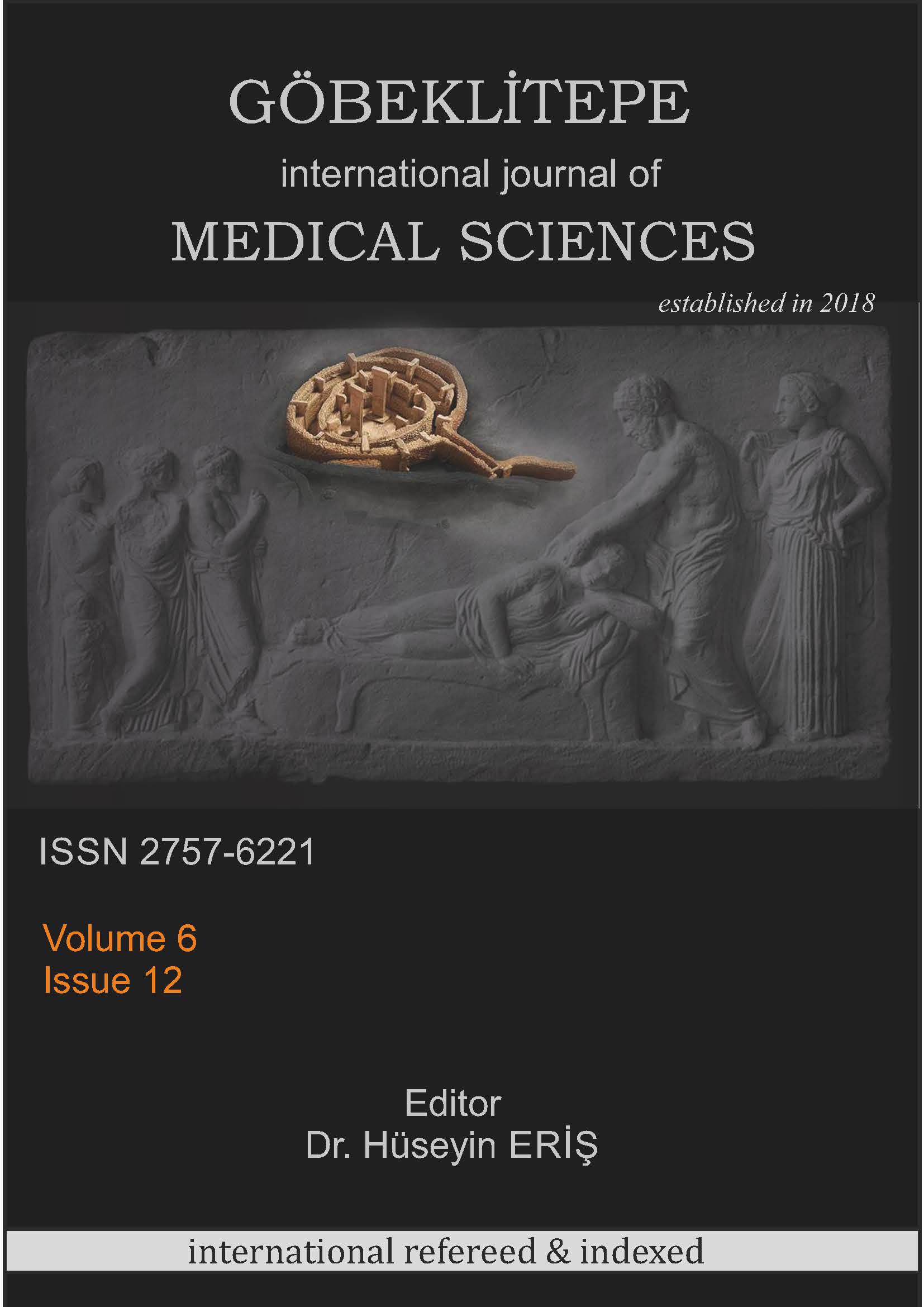PREDICTIONS TO STOP SMOKING OF PATIENTS AFTER CARDIOVASCULAR SURGERY
DOI:
https://doi.org/10.55433/gsbd/184Keywords:
Cardiovascular surgery, patient, SmokingAbstract
This study was conducted to examine the predictions of smoking cessation success of patients who smoke after cardiovascular surgery. Cross-sectional research Dr. The study was conducted with 92 patients who applied to the cardiothoracic surgery outpatient clinic of Ersin Arslan Training and Research Hospital for control purposes. Research data were collected between 20.09.2021 and 20.03.2022 with participant introduction form and Smoking Cessation Success Prediction Scale. Mann-Whitney U, Kruskal-Wallis and regression tests were used to evaluate the data. Necessary permissions were obtained to conduct the research. For all patients participating in the study, it was found that the total mean score of the Prediction Scale for Smoking Cessation Success was 39.47±5.48, the mean of Persistence and Readiness sub-dimension score was 22.34±2.94, and the mean of Health Perception and Appropriate Environment sub-dimension was 17.13±2.96. A significant difference was determined between the predictive score averages of smoking cessation success according to the age of starting smoking and the duration of smoking (F=9.662, p<0.001). It was determined that the predictive level of smoking cessation success in cardiovascular patients was above the average. The decrease in the smoking duration of the patients positively affects the predictive level of smoking cessation success.
References
Global Health Estimates: Life expectancy and leading causes of death and disability 2019. https://www.who.int/data/gho/data/themes/mortality-and-global-health-estimates Erişim Tarihi: 09.03.2021.
Sağlık Bakanlığı, Sağlık İstatistikleri Yıllığı, 2018. https://dosyasb.saglik.gov.tr/Eklenti/36134,siy2018trpdf.pdf?0 Erişim Tarihi: 09.03.2021.
World Health Organization. Noncommunicable diseases country profiles 2018. Geneva: World Health Organization; 2018. https://apps.who.int/iris/handle/10665/274512 Erişim Tarihi: 09.03.2021.
Sağlık Bakanlığı, Halk Sağlığı Kurumu 2021. Türkiye Kalp ve Damar Hastalıkları Önleme ve Kontrol Programı (2021-2026). https://hsgm.saglik.gov.tr/depo/birimler/kronik-hastaliklar-engelli-db/hastaliklar/kalpvedamar/kitap_ve_makale/KalpDamarEylemPlani _2021-2026.pdf Erişim Tarihi: 10.03.2021.
Dülek, H., Tuzcular, V.Z. & Gönenç, I. (2018). Kardiyovasküler hastalıklarda risk faktörleri. The Journal of Turkish Family Physician, 09(2), 53-58. doi: 10.15511/tjtfp.18.00253.
Taşkın Yılmaz, F. (2017). Kardiyovasküler Hastalıklar Risk Faktörlerinden Korunmada Hemşirenin Rolü. Online Türk Sağlık Bilimler Dergisi, 2(4),18-27.
Sağlık Bakanlığı, Halk Sağlığı Kurumu,2015. Türkiye Kalp ve Damar Hastalıkları Önleme ve Kontrol Programı. 2015. https://tkd.org.tr/TKDData/Uploads/files/Turkiye-kalp-ve-damar-hastaliklari-onleme-ve-kontrol-programi.pdf. Erişim Tarihi: 09.03.2021.
Tokgözoğlu, L., Kaya, E.B., Erol, Ç. & Ergene, O. (2010). EUROASPIRE III: Türkiye ile Avrupa’nın karşılaştırılması. Arch Turk Soc Cardiol, 38(3), 164-172.
Kotseva, K., Bacquer, D., Backer, G., Ryde´n, L., Jennings, C., Gyberg, V. et al. (2016). Lifestyle and risk factor management in people at high risk of cardiovascular disease. A report from the European Society of Cardiology European Action on Secondary and Primary Prevention by Intervention to Reduce Events (EUROASPIRE) IV cross-sectional survey in 14 European regions. European Journal of Preventive Cardiology, 23(18), 2007-2018. doi: 10.1177/2047487316667784.
WHO, Report On The Global Tobacco Epıdemıc, 2019. https://www.who.int/publications/i/item/WHO-NMH-PND-2019.5. Erişim Tarihi: 05.03.2021.
Aydemir, Y., Doğu, Ö., Dede, C. & Çınar, N. (2019). Sigara Bırakma Başarısı Öngörü Ölçeği: Geliştirme ve Geçerlik, Güvenirlik Çalışması. Addicta: The Turkish Journal on Addictions, 6, 387−402. http://dx.doi.org/10.15805/addicta.2019.6.2.0022.
Agency for Healthcare Research and Quality: Treating Tobacco Use and Dependence: 2008 Update. https://www.ahrq.gov/sites/default/files/wysiwyg/professionals/clinicians-providers/guidelines-recommendations/tobacco/clinicians/references/tobaccogenrefs.pdf Erişim Tarihi: 09.03.2021.
Korkmaz, G. & Şimşek Ç. (2017). Interventions intended for cigarette addiction. JAREN, 3(Ek sayı), 14-23.
Küresel Yetişkin Tütün Araştırması; Türkiye 2016 Verileri. http://www.halksagligi.hacettepe.edu.tr/duyurular/halkayonelik/kyta2016.pdf. Erişim Tarihi: 09.03.2021.
Tanımlı, E. (2020). Sigara Bırakma Başarısı Öngörü Ölçeği ile Nikotin Bağımlılığının Değerlendirilmesi. Sağlık Bilimleri Üniversitesi, Gaziosmanpaşa Sağlık Uygulama ve Araştırma Merkezi Aile Hekimliği Kliniği, İstanbul.
Mainali, P., Pant, S., Rodriguez, A.P., Deshmukh, A. & Mehta, J.L. (2015). Tobacco and cardiovascular health. Cardiovasc Toxicol, 15(2), 107–116. doi: 10.1007/s12012-014-9280-0.
Dessotte, C.A.M., Figueiredo, M.L., Rodrigues, H.F., Furuya, R.K., Rossi, L.A. & Dantas. R.A.S. (2016). Patient’s classification according to complications and mortality risks after elective heart surgeries. Revista Eletrônica de Enfermagem, 18, e1140. Doi: 10.5216/ree.v18.37736.
World Health Organization-MPOWER report 2008 https://apps.who.int/ iris/bitstream/handle/10665/43818/9789241596282_tur.pdf?sequence=6 &isAllowed=y. Erişim tarihi 03.04.2023
Moller, A. & Tonnesen, H. (2006). Risk reduction: perioperative smoking intervention. Best Practiseve Research Clinical Anaesthesiology, 20(2), 237-248. doi: 10.1016/j.bpa.2005.10.008.
Downloads
Published
Versions
- 2024-07-02 (2)
- 2023-06-23 (1)
How to Cite
Issue
Section
License
Copyright (c) 2023 Göbeklitepe Sağlık Bilimleri Dergisi

This work is licensed under a Creative Commons Attribution 4.0 International License.




